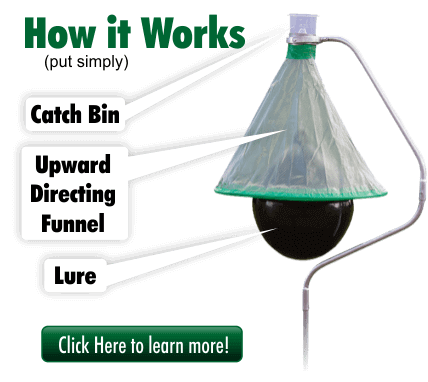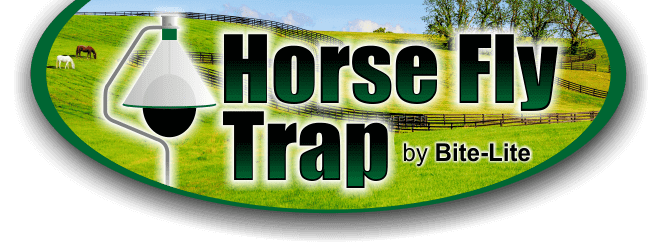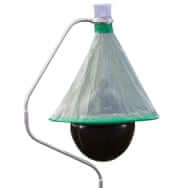Horse Fly Trap – Ships Quickly, Easy to Install, and Effective!
|
Ball |
Biting Fly Lure |
Collection Bin |
Funnel |
Horse-Fly-Trap |
HOLD YOUR HORSE (FLIES)! What’s an H-Trap?
Our horse fly trap is the best outdoor horse fly control system that money can buy! First disclaimer: you need female horse flies known as tabanids flying around your property and biting your beloved horses and family for it to work successfully! Our horse fly trap is well-designed and well-constructed for commercial and also residential use. If you don’t have the skills or inclination to build a horse fly trap yourself, and you want a quality horse fly trap that will reduce painful biting and vector born equine diseases, keep reading about the reason to purchase our horse fly trap today! Our horse fly trap uses no chemicals or electricity to catch female horse flies (the males don’t bite). Our horse fly trap has been scientifically proven to catch biting female horse flies better than any other commercial or government surveillance trap on the market. And our horse fly trap will last for many enjoyable years to come! If you have a sunny property with wet, damp areas, and are seeing nuisance horse flies flying about to find your horses, our horse fly trap is ideal for private and commercial horse stable yards. Our horse fly trap will also catch horse flies at other locations such as golf courses, botanical gardens, home gardens, meadows, ponds, swimming pools, water parks, state parks, business parks, vacation resorts, campgrounds, and RV parks. Start counting your acreage as one of our horse fly traps will cover about 2.5 acres or about 5 horses.
What Does Our Horse Fly Trap Catch?
 We know it is early in our introduction, but here is our second disclaimer! We want you to buy our horse fly trap for the right reasons, and not have unmet expectations or misconceptions about our uniquely designed product. What type of fly populations will our horse fly trap help collapse? Our horse fly trap only catches bloodsucking flies from a specific family of flies called the Tabanidae family. Tabanids are horse flies which are also called green heads, deer flies, yellow flies, and black B-52 bombers. While many of you are seeking the “cure” to stop all flies from biting and bothering your family and horses, please remember before clicking to purchase or unpacking your shipping box that not all biting flies are horse flies. Even if you see flies biting your horses, they may not be real “horse flies.” How can you make this distinction? Consider the environment where true horse flies breed. For example, do you or your neighbors have wet, swampy areas on your properties, the perfect habitat for horse fly eggs and larvae? What do the bloody wounds look like? If you are seeing trails of blood running down your horse’s legs rather than smaller dots of blood, you definitely have horse flies, who use their sharp mandibles to cut the skin and pump in a substance that allows the blood to flow.
We know it is early in our introduction, but here is our second disclaimer! We want you to buy our horse fly trap for the right reasons, and not have unmet expectations or misconceptions about our uniquely designed product. What type of fly populations will our horse fly trap help collapse? Our horse fly trap only catches bloodsucking flies from a specific family of flies called the Tabanidae family. Tabanids are horse flies which are also called green heads, deer flies, yellow flies, and black B-52 bombers. While many of you are seeking the “cure” to stop all flies from biting and bothering your family and horses, please remember before clicking to purchase or unpacking your shipping box that not all biting flies are horse flies. Even if you see flies biting your horses, they may not be real “horse flies.” How can you make this distinction? Consider the environment where true horse flies breed. For example, do you or your neighbors have wet, swampy areas on your properties, the perfect habitat for horse fly eggs and larvae? What do the bloody wounds look like? If you are seeing trails of blood running down your horse’s legs rather than smaller dots of blood, you definitely have horse flies, who use their sharp mandibles to cut the skin and pump in a substance that allows the blood to flow.
What Doesn’t Our Horse Fly Trap Catch?
 Our horse fly trap will NOT catch other annoying flies, such as stable flies (also known as filth flies) and horn flies. These biting flies are members of the Muscidae family. While these flies also bite horses and people, and help transmit several blood-borne parasites, they are not tabanids. In contrast to horse flies, stable fly and horn fly eggs and larvae breed closer to home and are prevalent in fecal matter, urine soaked bedding, or in the wet decomposing straw found around hay bales. Wounds are different as well. Bites from stable flies and horn flies are not as bloody, and you will see dots of blood left after feeding.
Our horse fly trap will NOT catch other annoying flies, such as stable flies (also known as filth flies) and horn flies. These biting flies are members of the Muscidae family. While these flies also bite horses and people, and help transmit several blood-borne parasites, they are not tabanids. In contrast to horse flies, stable fly and horn fly eggs and larvae breed closer to home and are prevalent in fecal matter, urine soaked bedding, or in the wet decomposing straw found around hay bales. Wounds are different as well. Bites from stable flies and horn flies are not as bloody, and you will see dots of blood left after feeding.
What Makes Our Horse Fly Trap So Special to Justify the Cost?
Our customers who offer their helpful reviews will consistently tell you that you get what you pay for, and our horse fly trap is worth every penny! Yes, it may be more expensive than others, but if your are looking for a horse fly trap that is sturdy — ours weighs 30 pounds out of the box– that is made with superior steel and plastic construction, please read on! No other horse fly trap on the market has a single anti rotation ground anchor rod. This makes our horse fly trap sturdy, wind resistant, and easy to mow around. The three piece steel frame is corrosion proof (dipped in hot zinc) and nearly 1/8 inch thick. (Compare this to the plastic, wood, and thinner metal legs of our competitors that often take off in the wind.)
The plastic used in the green conical hood and collection bin of our horse fly trap is UV proof, and will stand up to strong sunny rays over time. Compare our plastic parts to other horse fly traps using lightweight canvas that may blow away and will eventually fray, and non UV plastics that will crack or glass that will break. In addition, the green in our plastic conical hood was designed specifically to not attract such beneficial insects as honey bees.
As far as we know, there is no other horse fly trap out there that has a gyroscopic feature like ours that allows the ball, hood, and bin to move with the wind. The steel bracket at the top of our horse fly trap is attached to a stabilizing ring which allows movement and attracts roving horse flies. It also gives stability when the weather is windy and rainy.
How Does Our Trap Work?
 Essentially, it’s simple: the horse fly trap tricks the female horse fly into finding the black ball! In its adult stage, the female horse fly is in search of blood to help her reproduce and fertilize her eggs. Once the three piece steel coated frame is bolted and set in place and the large black ball is inflated and gets hot just like a dark tee shirt would from the heat of the sun, the trickery will begin and the female horse flies will find the horse fly trap by infrared signature. Once landed on the heated ball, the female horse fly will look to “feed”, and failing to get its intended blood meal, the female will fly up into the green conical hood and finish its flight pattern into the plastic collection bin at the very top of the horse fly trap.
Essentially, it’s simple: the horse fly trap tricks the female horse fly into finding the black ball! In its adult stage, the female horse fly is in search of blood to help her reproduce and fertilize her eggs. Once the three piece steel coated frame is bolted and set in place and the large black ball is inflated and gets hot just like a dark tee shirt would from the heat of the sun, the trickery will begin and the female horse flies will find the horse fly trap by infrared signature. Once landed on the heated ball, the female horse fly will look to “feed”, and failing to get its intended blood meal, the female will fly up into the green conical hood and finish its flight pattern into the plastic collection bin at the very top of the horse fly trap.
Learn more on our Horse Fly Trap Science Page
How Fast Does Our Horse Fly Trap Work?
While you will read reviews from some of our customers that they are seeing instantaneous results after installation, as a general rule, don’t expect a horse fly trap to catch horse flies right away. It may take several weeks to begin to reduce a vibrant population of nasty horse flies!
Darwin’s theory of evolution holds true for horse flies too! Horse flies have learned to locate and bite warm blooded horses and other mammals, including us. Any horse fly trap on the market is, at best, a close second choice for the female horse fly who needs blood to fertilize her eggs and reproduce. Therefore, as long as you are still seeing horse flies on your property, no horse fly trap will entirely prevent you or your animals from getting bitten. But if you have the patience to start collapsing your horse fly populations, purchase our horse fly trap right away!
We have one last disclaimer regarding whether the H-Trap will meet your expectations. We have learned that on certain properties there may be certain elements that could compete with the effectiveness of one H-Trap. For example, the following could produce more thermal energy or heat signatures than the trap’s black ball and could affect successfully finding an effective location for the H-Trap: blue plastic pool liners, dark horses, metal roofs, other blue or dark objects. If that is the case, we recommend trying an integrated pest management program, adding a lure to the H-Trap, and white fly sheets and fly sprays on your horses to your regimen. Please give us a call and we can share other tips with you to help manage the property.
Study: Research Study Confirms H-Trap’s Superiority in Standing Up to the Elements and Catching Horse Flies!
“Overall, the H-trap caught the most specimens and the greatest number of species. This trap was considerably easier to service by just removing/lifting off the entire collection container. Conversely, the collection container of the HP [Horse Pal] trap often came apart while removing it, and that could have resulted in losing part of the collection if care was not taken. During these trials, we found that the H-trap was more stable during very windy conditions (>30 mph). Although the experiments reported herein were not affected, there were several times between experiments that the HP and Nzi-SB were blown over by very windy conditions, but H-traps remained intact. This observation was further supported during ongoing studies when tropical storm Hermine (sustained winds of 39-73 mph with wind gusts of 74-110 mph) ravaged Cedar Key causing severe wind damage to homes and businesses but did no damage to seven H-traps that had been left in the field during the storm.most effective and sturdiest horse fly trap out there among other commercial and government surveillance traps on the market…”





